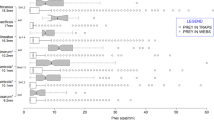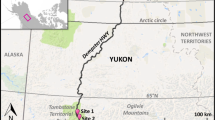Summary
Increased prey capture efficiency in colonial spiders is a consequence of the “ricochet effect”, as prey are captured after they bounce off several webs in succession. In this study, the prey capture of three species of colonial spiders in the genus Metepeira from Mexico are compared. These species, from different habitats, show varying levels of social organization (group size and withingroup spacing) that affect prey capture from ricochets. Metepeira sp. a (a presumed new species tentatively named atascadero) from desert grassland habitats, occur solitarily or in small groups, and gain little from prey ricochets: prey capture rates are low and variance in prey captured/spider is high. M. spinipes, from mesic agricultural sites, occur in groups of 10–150, and show a ricochet effect resulting in more and larger prey, and reduced variance in capture rate. M. incrassata, from tropical rainforest/agricultural sites, occur in large colonies of hundreds to thousands of individuals, and show a similar ricochet effect. The ricochet effect does not influence taxonomic composition of prey in either M. atascadero or M. spinipes, but does in tropical M. incrassata. This result, however, is primarily due to the capacity of certain taxa (eg., Lepidoptera), more common in the tropics, to escape more easily from spider webs. A comparison of prey capture efficiency of colonial M. incrassata with that of solitary M. atascadero shows that the ricochet effect provides an increase in efficiency across all size classes of prey.
Similar content being viewed by others
References
Benton MJ, Uetz GW (1986) Variation in life-history characteristics over a clinal gradient in three populations of a communal orb-weaving spider. Oecologia 68:395–399
Burgess JW, Uetz GW (1982) Social spacing strategies in spiders. In: Witt PN, Rovner JS (eds) Spider communication, mechanisms and ecological significance. Princeton University Press
Buskirk RE (1975a) Aggressive display and orb defence in a colonial spider, Metabus gravidus. Anim Behav 23:560–567
Buskirk RE (1975b) Colbniality, activity patterns and feeding in tropical orb-weaving spider. Ecology 56:1314–1328
Buskirk RE (1981) Sociality in the Arachnida. In: Hermann HR (ed) Social insects. Vol. II, Ch. 7
Cangialosi KR, Uetz GW (1987) Spacing in colonial spiders: effects of environment and experience. Ethology 76:236–246
Crook J (1965) The adaptive significance of avian social organizations. Symp Zool Soc Lond 14:181–218
Eisner T, Alsop R, Ettershank G (1964) Adhesiveness of spider silk. Science 146:1058–1061
Enders F (1975) Change of web site in Argiope spiders (Araneidae). Amer Midl Natur 94:484–490
Gillespie RG (1987) The role of prey availability in aggregate behaviour of the orb weaving spider Tetragnatha elongata. Anim Behav 87:675–681
Honjo S (1977) Social behavior in Dictyna foliicola (Araneae: Dictynidae). Acta Arachnol 27:213–219
Ivlev V (1961) Experimental ecology of the feeding of fishes. Yale University Press, New Haven
Lubin YD (1973) Web structure and function: the non-adhesive orb-web of Crytophora moluccenis (Doleschall) (Araneae: Araneidae). Forma et functio 6:337–358
Lubin YD (1974) Adaptive advantages and the evolution of colony formation in Cyrtophora (Araneae: Araneidae). Zool J Linn Soc 54:321–339
Murton RK (1971) Why do some bird species feed in flocks? Ibis 113:534–536
Nentwig N (1982) The selective prey of Linyphiid-like spiders and of their space webs. Oecologia 45:236–243
Nentwig W (1982) Why do only certain insects escape from a spider's web? Oecologia 53:412–417
Nentwig W (1983a) The non-filter function of orb webs in spiders. Oecologia 58:418–420
Nentwig W (1983b) The prey of web-building spiders compared with feeding experiments (Araneae: Araneidae, Linyphiidae, Pholcidae, Agelenidae). Oecologia 56:132–139
Nentwig W (1985a) Prey analysis of four species of tropical orbweaving spiders (Araneae: Araneidae) and a comparison with araneids of the temperate zone. Oecologia 66:580–594
Nentwig W (1985b) Social spiders catch larger prey: a study of Anelosimus eximius (Araneae: Theridiidae). Behav Ecol Sociobiol 17:79–85
Nentwig W (1986) A comparison of prey lengths among spiders. Oecologia 68:595–600
Riechert SE, Luczak J (1982) Spider foraging: behavioral responses to prey. In: Witt PN, Rovner JS (eds) Spider communication; mechanisms and ecological significance. Princeton University Press
Rypstra AL (1979) Foraging flocks of spiders — a study of aggregate behavior in Crytophora citricola Forskal (Araneae: Araneidae) in West Africa. Behav Ecol Sociobiol 5:291–300
Rypstra AL (1983) The importance of food and space in limiting web-spider densities; a test using field enclosures. Oecologia 59:312–316
Rypstra AL (1985) Aggregations of Nephila clavipes (L.) (Araneae: Araneidae) in relation to prey availability. J Arachnol 13:71–78
Rypstra AL (1986) High prey abundance and a reduction in cannibalism: the first step to sociality in spiders (Arachnida). J Arachnol 14:193–200
Rypstra AL (1989) Foraging success of solitary and aggregated spiders: insights into flock formation. Anim Behav 37:274–281
Shear WA (1970) The evolution of social phenomena in spiders. Brit Arachnol Soc 1:65–76
Tietjen WJ (1986a) Effects of colony size on web structure and behavior of the social spider Mallos gregalis (Araneae: Dictynidae). J Arachnol 14:145–158
Tietjen WJ (1986b) Social spider webs, with special reference to the webs of Mallos gregalis. In: Shear WA (ed) Spiders: webs, behavior, and evolution. Stanford University Press
Uetz GW (1985) Ecology and behavior of Metepeira spinipes (Araneae: Arancidae), a colonial web-building spider from Mexico. Nat Geogr Res Rep 19:597–609
Uetz GW (1986a) (ed) Symposium: social behavior in spiders. J Arachnol 14:145–281
Uetz GW (1986b) Web-building and prey capture in communal orb weavers. In: Shear WA (ed) Spiders: webs, behavior, and evolution. Stanford University Press
Uetz GW (1988a) Risk sensitivity and foraging in colonial spiders. In: Slobodchikoff CN (ed) Ecology of social behavior. Academic Press, New York
Uetz GW (1988b) Group foraging in colonial web-building spiders: evidence for risk-sensitivity. Behav Ecol Sociobiol 22:265–270
Uetz GW, Burgess JW (1979) Habitat structure and colonial behavior in Metepeira spinipes (Araneae: Araneidae), an orb weaving spider from Mexico. J Arachnol 7:121–128
Uetz GW, Kane TC, Stratton GE (1982) Variation in the social grouping tendency of a communal web-building spider. Science 217:547–549
Uetz GW, Cangialosi KR (1986) Genetic differences in social behavior and spacing in populations of Metepeira spinipes Pickard-Cambridge (Araneae: Araneidae), a communal-territorial orb weaver. J Arachnol 14:159–174
Uetz GW, Kane TC, Stratton GE, Benton MJ (1987) Environmental and genetic influences on the social grouping tendency of a communal spider. In: Huettel MA (ed) Evolutionary genetics of invertebrate behavior. Plenum Press
Ward P, Zahavi A (1973) The importance of certain assemblages of birds as “information centres” for food finding. Ibis 119:517–534
Wittenberger JF (1981) Animal social behavior. Duxbury Press
Author information
Authors and Affiliations
Rights and permissions
About this article
Cite this article
Uetz, G.W. The “ricochet effect” and prey capture in colonial spiders. Oecologia 81, 154–159 (1989). https://doi.org/10.1007/BF00379799
Received:
Accepted:
Issue Date:
DOI: https://doi.org/10.1007/BF00379799




